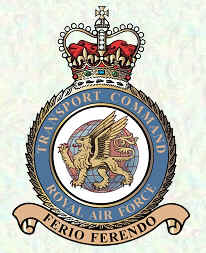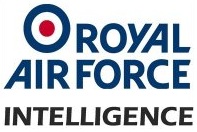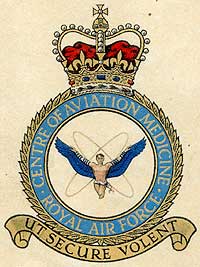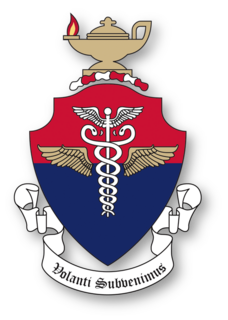
The Royal Air Force Institute of Aviation Medicine was a Royal Air Force aviation medicine research unit active between 1945 and 1994.

The Royal Air Force Institute of Aviation Medicine was a Royal Air Force aviation medicine research unit active between 1945 and 1994.
The RAF Institute of Aviation Medicine (IAM) was opened on 30 April 1945 by the Princess Royal. It was located on land to the south side of the Farnborough Airfield in Hampshire, and was successor to the wartime RAF Physiological Laboratory. Initially having separate sections for acceleration, altitude, biochemistry, biophysics, personal equipment and teaching, its mandate was to conduct both pure and applied research in support of flying personnel. Initially run by Dr Bryan Matthews, Group Captain Bill Stewart was appointed head in 1946. A former pupil of the Hamilton Academy school, Stewart was to be promoted to Air Vice-Marshal, and awarded CB and CBE. The Stewart Lecture at the Royal Aeronautical Society was established in his memory in 1969. [1] [2] [3]
The IAM obtained a decompression chamber (moved from the Physiological Laboratory) in 1945, and this was supplemented by a climatic chamber in 1952, and human centrifuge in 1955 (the latter facility is still in operation and was designated a Grade 2 Listed Building in August 2007).
Additionally, the Institute was responsible for a number of mobile decompression chambers and the training of operators for chambers deployed at certain RAF operational stations with the object of familiarising flying personnel with the effects of anoxia at operational altitudes.
The IAM became a world leading centre for aviation medicine research in the 1960s and 1970s, gaining additional facilities, and continuing an active flight research programme that commenced in World War II. Research into protection against the effects of high altitude, high G force, heat and cold stress, noise and vibration, sleep and wakefulness, spatial disorientation, vision, aviation psychology and human error, and aircraft accident investigation dominated activities at the IAM. Much work was done to develop and improve aircrew life support equipment.
The IAM ceased to exist in 1994, when many research staff and facilities were transferred to the DERA Centre for Human Sciences. In the RAF, the spiritual successor to the IAM is the RAF Centre of Aviation Medicine, which opened in 1998 at RAF Henlow in Bedfordshire, and conducts training and operational support for RAF aircrew.

A flight surgeon is a military medical officer practicing in the clinical field of aviation medicine. Although the term "flight surgery" is considered improper by purists, it may occasionally be encountered.

RAF Transport Command was a Royal Air Force command that controlled all transport aircraft of the RAF. It was established on 25 March 1943 by the renaming of the RAF Ferry Command, and was subsequently renamed RAF Air Support Command in 1967.

The Royal Aeronautical Society, also known as the RAeS, is a British multi-disciplinary professional institution dedicated to the global aerospace community. Founded in 1866, it is the oldest aeronautical society in the world. Members, Fellows, and Companions of the society can use the post-nominal letters MRAeS, FRAeS, or CRAeS, respectively.

Royal Air Force Cranwell or more simply RAF Cranwell is a Royal Air Force station in Lincolnshire, England, close to the village of Cranwell, near Sleaford. Among other functions, it is home to the Royal Air Force College (RAFC), which trains the RAF's new officers and Aircrew. The motto, Altium Altrix, meaning "Nurture the highest" appears above the main doors of the Officers Mess. RAF Cranwell is currently commanded by Group Captain Joanne Campbell.
No. 5 Group was a Royal Air Force bomber group of the Second World War, led during the latter part by AVM Sir Ralph Cochrane.

RAF North Luffenham was a Royal Air Force station in Rutland, England, 1940 - 1998. It is near to the villages of Edith Weston and North Luffenham.

A pressure suit is a protective suit worn by high-altitude pilots who may fly at altitudes where the air pressure is too low for an unprotected person to survive, even breathing pure oxygen at positive pressure. Such suits may be either full-pressure or partial-pressure. Partial-pressure suits work by providing mechanical counter-pressure to assist breathing at altitude.

Intelligence services in the Royal Air Force are delivered by Officers of the Royal Air Force Intelligence Branch and Airmen from the Intelligence Analyst Trade and Intelligence Analyst (Voice) Trade. The specialisation has around 1200 personnel of all ranks posted to operational air stations, HQs and other establishments of the British Armed Forces, both in the United Kingdom and overseas.

A hypobaric chamber, or altitude chamber, is a chamber used during aerospace or high terrestrial altitude research or training to simulate the effects of high altitude on the human body, especially hypoxia and hypobaria. Some chambers also control for temperature and relative humidity.
DRDC Toronto is a major military research station located at the former site of CFB Downsview in Toronto, Ontario, Canada. It is one of several centres making up Defence Research and Development Canada (DRDC).

The Royal Air Force Search and Rescue Force was the Royal Air Force organisation which provided around-the-clock aeronautical search and rescue cover in the United Kingdom, Cyprus and the Falkland Islands, from 1986 until 2016.
Air vice-marshal John "JE" Ernsting was a senior Royal Air Force (RAF) commander and renowned medical researcher.
The Royal Air Force Medical Services is the branch of the Royal Air Force that provides health care at home and on deployed operations to RAF service personnel. Medical officers are the doctors of the RAF and have specialist expertise in aviation medicine to support aircrew and their protective equipment. Medical officers also carry out Aeromedical evacuations, providing vital assistance on search-and-rescue missions or emergency relief flights worldwide.
The Center for Studies and Research on Aeronautical Medicine was an aviation medicine organisation in Guidonia Montecelio.

The RAF Centre of Aviation Medicine is a medical organisation run by the Royal Air Force and based at RAF Henlow in Bedfordshire. It is the main organisation conducting aviation medicine research in the UK.
Air Marshal Sir Harold Edward Whittingham was a British physician notable for a distinguished medical career in the Royal Air Force and contributions to Aviation medicine. After graduating from the University of Glasgow, he was the first pathologist and Assistant Director of Research at the Beatson Institute for Cancer Research in Glasgow.
Air Vice Marshal William Kilpatrick Stewart, was a Scottish researcher in aerospace physiology, senior consultant in physiology to the Royal Air Force, and commanding officer of the RAF Institute of Aviation Medicine.
Sir Bryan Harold Cabot Matthews, was Professor of Physiology, Cambridge University 1952–1973, emeritus professor thereafter and Life Fellow of King's College, Cambridge.
The Royal Australian Air Force Institute of Aviation Medicine (AVMED) ensures the effectiveness and safety of Australian Defence Forces (ADF) air operations by conducting research and training ADF aircrew to understand and manage the physiological challenges of flight. AVMED is currently staffed by a mixture of uniformed and civilian personnel bringing with them diverse skills in aviation medicine, human factors, and life support.

The United States Air Force School of Aerospace Medicine (USAFSAM) is the United States Air Force (USAF) organization focused on education, research, and operational consultation in aerospace and operational medicine. USAFSAM was founded in 1918 to conduct research into the medical and physiologic domains related to human flight, and as a school for medical officers trained to support military aviation operations, later coined as flight surgeons. The school supported early military aviation from World War I through the evolution of aviation and into the modern era. USAFSAM conducted medical research and provided medical support for the initial US space operations beginning in 1947 through the establishment of NASA in 1958. After the creation of NASA, USAFSAM continued to actively support civilian and military manned space missions through clinical and physiologic research. USAFSAM is one of the oldest continually operating school for flight surgeons and other operational medical personnel of its kind in the world. USAFSAM is located in Dayton, Ohio at Wright-Patterson Air Force Base, and is part of the 711th Human Performance Wing and the Air Force Research Laboratory (AFRL).